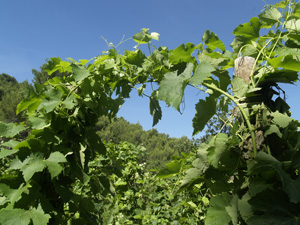
Tagged articles : Wine

Get involved in the grape harvest in an organic French vineyard.
- Categories :
- Gifts
- Wine
- Wine Making
- Enjoying Wine
- Gourmet Odyssey
The date of the harvest depends on many factors; the weather, the grape varietal, the type of wine, but it fundamentally comes down to the maturity of the grapes, and finding that perfect balance between sugar and acidity. The winemaker will then choose the optimum moment to harvest the grapes and make the wine to the desired taste.
Gourmet Odyssey offers Harvest Experience Days where you can get involved in the harvest at one of our 6 organic partner wineries. The aim is to participate in and learn from the winemaker about the process to harvest the grapes through to putting them in the fermentation tanks.
Armed with a pair of secateurs and a bucket, the winemaker will show you how to cut the bunches and to select the best grapes. Once you’ve finished the harvest, you’ll follow their journey back to the chai.
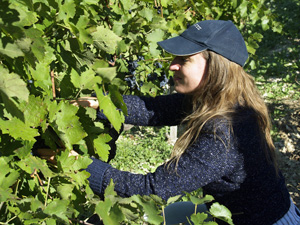
You’ll also enjoy a wine tasting session, because after the effort, the just reward! And then you will sit down to the harvesters’ lunch, accompanied by a selection of wines, where you can talk with the winemakers and learn more about how they work organically and the challenges in doing so. It’s a very privileged moment!
Then discover the work in the cellar during harvest time. You’ll get involved in sorting the grapes and putting them into the vats, where you’ll learn about the fermentation process. The day will be over before you know it, but you’ll be much wiser about all of the work and effort that goes into harvesting and making wine.
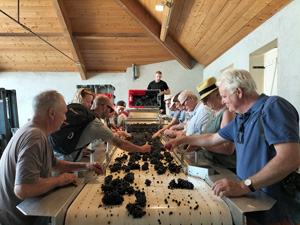
The little extra? Each Harvest Experience Day is valid for two people! And what’s more, when you buy a Gourmet Odyssey Wine Experience, you also have some adopted vines included that you’ll get to meet when you go to the winery for the harvest. You’ll follow the making of your wine, and will receive a bottle of wine for each adopted vine, using the grapes that you have helped to harvest. So, are you ready to meet up for the harvest?
Discover more about the Gourmet Odyssey Wine Experience.
We spent an excellent Discovery Experience Day at Château Cohola in the Côtes du Rhône village of Sablet. Accompanied by the winemakers, Cheli and Jérôme Busato, we learnt a lot about their efforts in the vineyard to produce the best possible grapes, and we’ll be sure to better appreciate the bottles of wine that we open from now on!
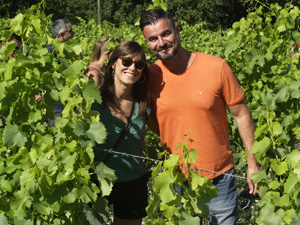
After the introductions to the winery, the winemakers, and the region’s wines, we headed straight out into the vineyard. Our first stop was to visit our adopted vines! Thanks to a small blackboard, we were able to find and introduce ourselves to our micro-plots of vines and take a few souvenir photos.
Cheli and Jérôme explained the work that they had carried out in winter and the start of spring to prune and de-bud the vines in order to reduce the quantity of grapes produced by each vine with the aim of improving the quality.
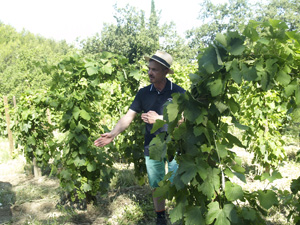
The winery is made up of 15 terraced vineyards, and Jérôme and Cheli showed us the different grape varietals and pruning methods that they use. The vines had grown lots over the past few weeks, and we stopped in front of a plot of staked vines.
Next to each vine was a large wooden stake, or échalas, to which the vine was attached to help support the weight of the grapes and leaves. Our mission was to take the tops of the branches, divide them in two, and weave them together with those from the neighbouring vines to form arches. The arches make the vines more stable, protecting them from the winds that often blow hard in this region, and give some more shade to the grapes to protect them from the sun.
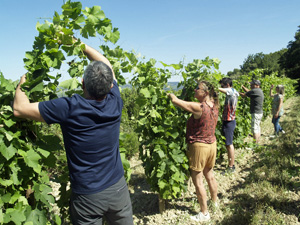
Jérôme and Cheli showed us how to create the arches, and then we spread out between the rows to have a go ourselves. At first, we were scared of damaging the branches, but we quickly learnt that they are stronger than you think, and we started to advance more quickly!
We continued our stroll through the vineyards until we reached the highest point of the estate, where we stopped to admire the wonderful view overlooking the village of Sablet and the plains of the Rhone Valley below. Jérôme enlightened us as to how they work organically and the challenges of doing so, and he explained the work that remains to be done between now and the harvest.
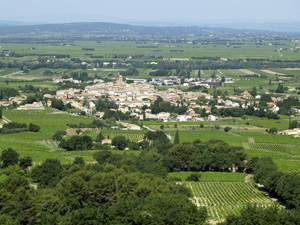
Aperitif time had arrived, and so we made our way down to the village and met up in a local restaurant for a nice fresh glass of 2022 Sablet rosé from the winery which has the peculiarity of being a blend of press and bled rosé wines.
With the aubergine papeton starter, Cheli served us their 2022 Sablet Cuvée Fruit, a light and fruity red wine that she had made specially for drinking chilled. Absolutely fantastic! With the chicken Provencal main course, we tasted the 2019 vintage of the Sablet wine that has been chosen for the clients of the Gourmet Odyssey Wine Experience.
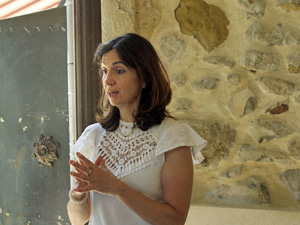
Cheli and Jérôme are also beekeepers, and so with the goat’s cheese, they honoured us by serving squares of honeycomb. An unforgettable experience, accompanied by the excellent 2022 Sablet white wine. And with the home-made cherry clafoutis dessert, we tasted the powerful TBF wine that had been aged in wood, clay, and steel cotenants.
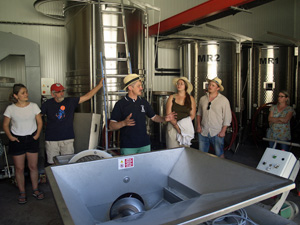
After lunch, we went to the chai. Jérôme showed us where the grapes will be received at harvest time and gave us a quick introduction to the work in ageing wine. We’ll spend more time here in September during the Harvest Experience Day and in spring for the Vinification Experience Day.
Many thanks to Cheli and Jérôme for this fascinating day spent in this wonderfully relaxing spot.
Since March, we have welcomed groups of wine lovers to Domaine Chapelle in the picturesque Burgundy village of Santenay for the Discovery Experience Days. These hands-on Wine Experience Days aim to better understand the work of the winemaker in the vineyard to produce the best quality grapes for harvesting.
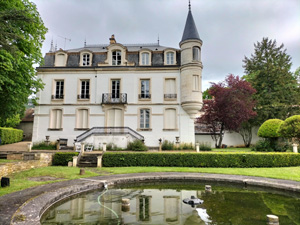
After the welcome and briefing of the day’s programme, Jean-François Chapelle recounted the history of his family, his winery, and of Burgundy wines.
We then set out into the vineyard to meet our adopted vines, whisper them a few sweet words, and take some photographs to immortalise the moment!
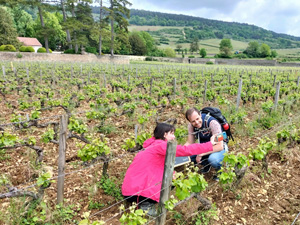
We were joined by Jean-François’ son, Simon, who has been managing the vines and vinification process since 2021. Jean-François is progressively taking his retirement and passing on the reigns to Simon.
Simon explained the whole vegetative life cycle from pruning through to the harvest, and we quickly learnt that the work carried out in the vineyard demands lots of manual effort.
Pruning is done between January and April, before the branches are arced and attached to the bottom training wire to delay the moment when the buds burst, with the aim of reducing the risk of being impacted by any frosts. The participants of the Discovery Experience days in March were able to witness the complexity of pruning!
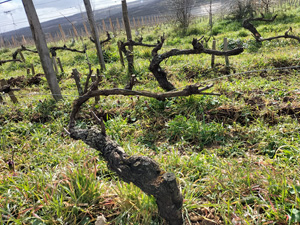
The buds burst in the second half of April, and the vines started to grow the fruit-bearing branches for this new season.
In May, the main job was de-budding the vines, which involves removing any double shoots and unwanted branches to limit the quantity of grapes that each vine can produce. It’s a job that demands dexterity and some thought, as the participants of the May Discovery Experience Day found out by de-budding some vines for themselves. There is always the fear of damaging the vines or choosing the wrong branch to remove, but it’s only by doing that you really learn.
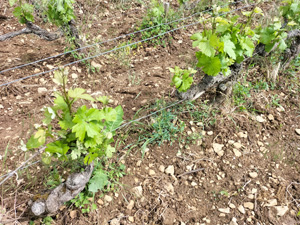
The branches grew rapidly in May, and so we had to return to each vineyard plot to raise the training wires twice, finishing by trimming the tops of the vines to stop the branches from becoming too intertwined. Raising the training wires was the task we were set for the Discovery Experience Days in June and July.
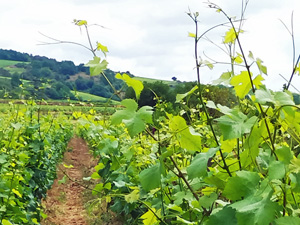
Domaine Chapelle has been adhering to the organic charter for 15 years now, working the soil mechanically and only using treatments permitted in organic agriculture. We spent quite a bit of time discussing how to work they work organically at the vineyard and the challenges of doing so.
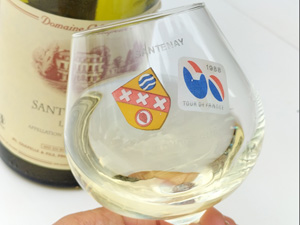
After these great mornings spent in the vineyard, we returned to the winery for a nice glass of fresh Santenay white wine, accompanied by the famous Burgundy gougères. We then sat down to lunch with three food and wine parings: the fish terrine starter served with a Burgundy Aligoté, the Gaston Gérard chicken main course paired with the Clos des Cornières Santenay red wine, and the chocolate and blackcurrant dessert accompanied by a Santenay Premier Cru.
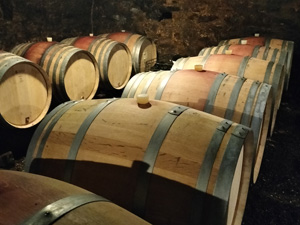
Depending on the weather, in the afternoon, we went for a walk through the vineyards to see the different terroir and/or we visited the cellar to have a glimpse of what we’ll cover in much more detail during the Vinification Experience Days next spring.
But the next rendez-vous is to meet up for the Harvest Experience Days in September to harvest the grapes from our vines!
We met up at the magnificent Château Coutet, a family-run winery, very close to the centre of this beautiful medieval town that is renowned throughout the world for the quality of its wine. We were to spend the day with one of the winemaking owners, Alain David-Beaulieu. The aim of the day was to discover the daily work of a winemaker. The vines had already grown lots by the end of June, and we could already see the future grapes well formed on the vines.
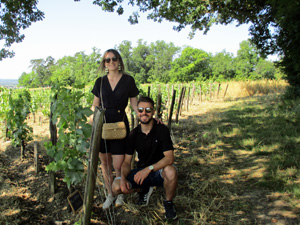
After a quick tour of the estate and our adopted vines, Alain explained the different work that has been carried out in the vineyard since winter. It all started with pruning the vines to control the quantity of grapes produced and to limit how much the vines spread. Once the vines start to grow, the best fruit-bearing branches were selected, and any shoots that wouldn’t produce any grapes removed, so as to preserve the vines energy on producing better quality grapes. Then came the raising of the training wires to keep the vines nicely aligned and supported between two wires. This enables the tractors to continue to pass through the vine rows without hindrance or damaging the vines.
Alain had kept a little work back for us to do, and so after all the explanations, we got to experience firsthand what it’s like to work in a vineyard.
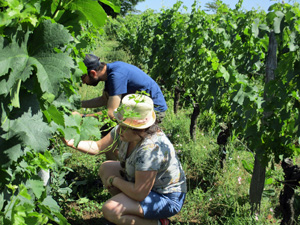
Removing some of the leaves from the zone around the grapes is very important for the vines, as it improves the airflow, as they can bring dampness. Spring was fairly wet and humid this year, increasing the risk of fungi such as mildew forming which can quickly destroy the work of a whole season by drying out the future grapes, which then can’t be used to make wine.
After having a go for ourselves, we soon learned that it’s a physical job, especially so if it’s done for many days and even weeks in a row! Producing quality grapes demands a lot of effort!
But after the effort, the just reward! We all ate a lovely meal together and delighted our taste buds with the wines from the estate under the shade of the tress in the garden.
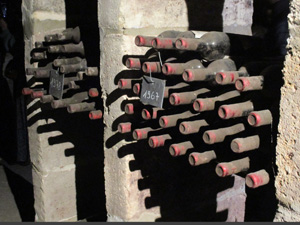
In the afternoon, we visited the chai and talked more about the challenges of working organically. We finished the day with a visit of the family cellar where the old vintage wines are stored!
This immersive day proved to be very interesting and we thank Alain warmly for his welcome. We can’t wait to come back for the Harvest Experience Days in September!
In May and June, we visited Château de Jonquières, a magnificent family-run winery in the Terrasses du Larzac wine-growing region, to spend a couple of Discovery Experience Days with the winemakers, Charlotte and Clément de Béarn. The aim of these Wine Experience days is to learn about all the work that goes on in an organically certified vineyard.
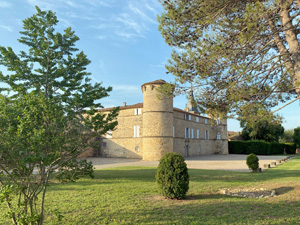
We were welcomed by Gaël, the Gourmet Odyssey wine specialist, and the winemakers who gave us an introduction to the château and its history that has been passed down through 32 generations.
The days were focused mainly on the work in the vineyard, but we had to be flexible in May to avoid the showers. Charlotte and Clément were all smiles to see the rain because the winter had been very dry and the vines were desperately in need of water. Clément assured us that there would be enough dry patches to be able to do some work in the vineyard, and he was right!
Once in the vineyard, Charlotte and Clément explained the work that had been done during the winter and early spring, most notably to prune the vines. In spring the vines need lots of care to keep them healthy, and accompany them in preparing them for an optimal harvest. The vines had already grown quickly, so there were two tasks awaiting our help.
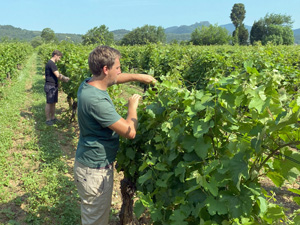
First we raised the training wires in a couple of rows of Cinsault to trap the branches between them. This helps the vines to support the weight of the grapes and foliage.
We also de-budded the vines by removing the young shoots that had sprouted from the vine trunks and might transport disease from the soil to the vines. We also removed any double-buds in a plot of Carignan, leaving the best branches to bask in the sun and to have a better airflow around them so that they dry more quickly, again reducing the risk of disease.
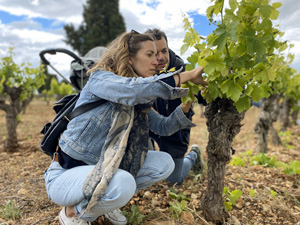
After the effort, we were rewarded back at the château with a well earned aperitif and winemakers lunch. Charlotte and Clément had selected 5 of their wines to accompany the delicious meal which had been prepared by a local chef, Aubin Vie.
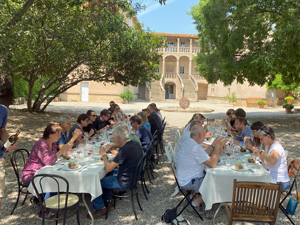
The meal is always a lovely moment when the participants get to ask lots of questions to the winemakers about their life, daily routine, and the differences between the wines that we were tasting.
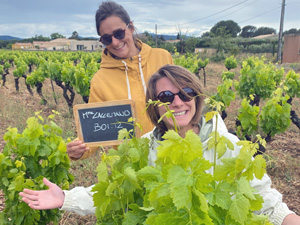
In the beginning of the afternoon, we went on a little stroll to visit our adopted vines. It’s a great spot, and the 70 odd year old Carignan vines that were planted by Charlotte’s grandmother are a sight to behold.
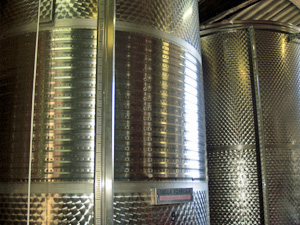
The days finished in the chai where Clement enlightened us a little to his universe and the tools he uses to receive the grapes at harvest time. We’ll see all of that in action when we return to the winery in September for the Harvest Experience Day!
We spent a great day in Alsace at Domaine Stentz-Buecher for a Gourmet Odyssey Discovery Experience Day. These hands-on wine experience days at the winery enable wine lovers to discover all the work that goes on in the vineyard needed to make a great wine.
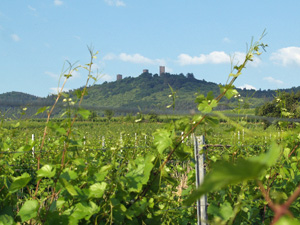
We were welcomed by Céline and Stéphane, the winemakers at Domaine Stentz-Buecher. After the introductions, we headed straight out and made our way to the Rosenberg vineyard, where our adopted vines are located.
A little surprise was waiting for us! A nameplate had been put in front of our adopted vines, and so we set out to acquaint ourselves with them, and take a few photos to immortalise the moment!
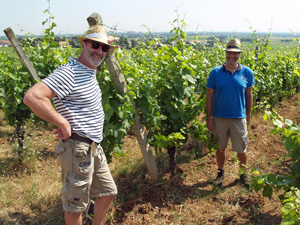
To make good wine, you need good ingredients, and the choices that the winemakers take and the quality of the work in the vineyard will have a big impact on the quality of the grapes at harvest time. The weather also plays its part of course, but let’s stay focused on the factors we can control!
Stéphane and Céline explained the work that has been done since the last harvest, notably to prune the vines and attach the selected branches to the training wire.
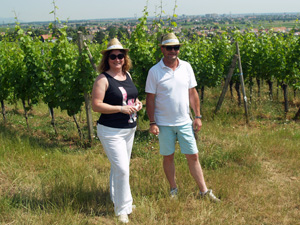
The flowering period went well in early June, and now the vines are in full growth mode to form the grape bunches and grow the leaves needed to ripen them through photosynthesis. There’s lots of work to be done and so our help was very welcome!
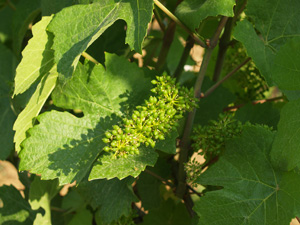
Our first task was to train the vines onto the trellis system. When the branches grow, they fall into the middle of the row, and sometimes to the ground. Without any intervention, two big problems are quickly encountered. Firstly, the tractor won’t be able to pass down the row to treat and work the vines without breaking the branches. And secondly, the risk of spreading disease from one row to another, or from the ground, is increased.
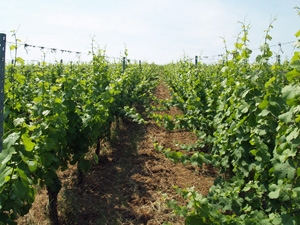
Stéphane showed us how to raise the branches and place them between the training wires of the trellis system. Then in pairs, we spread out to start our newfound profession of being a winemaker! At first we were a little hesitant, so as not to damage or break any of the branches, but we quickly understood that the branches are much more robust that you would think!
Stéphane also asked us to de-bud the vines as we went down the rows if we saw any shoots that had sprouted from the lower trunk of the vines. These shoots won’t produce any grapes, so it’s best to remove them to concentrate the vine’s energy on the fruit-bearing branches.
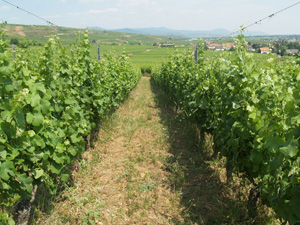
When we arrived at the end of the row, it was with great satisfaction that we turned around to admire our work!
On our way back to the winery, Céline showed us a plot of young vines that had just been planted. She explained how important it is to plan ahead and coordinate the replanting schedule with the other plots to best manage the continuity of production across the winery, as you need to allow for a good ten years from the moment you pull up the old vines, to the moment that you can start harvesting grapes that begin to be of an interesting quality.
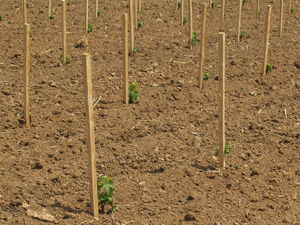
Back at the winery, we went down into the cool of the cellar and gathered in the impressive wine library where the old vintage wines are stored. And yes, it’s not just red wines that you can conserve!
Céline had prepared a great wine tasting session to reward us after our morning’s effort, starting with the fresh and crisp 2019 Muscat Rosenberg. We then tasted the very aromatic 2014 Riesling Tannenbuehl cuvée Flavien, a wine that is already almost 9 years old and which can happily be kept for a fair few more years to come. Next up was the 2021 Pinot Gris Rosenberg, the wine chosen for the Gourmet Odyssey Wine Experience, followed by the Brut Nature Crémant d’Alsace sparkling rosé wine to finish, accompanied by some savoury kouglof.
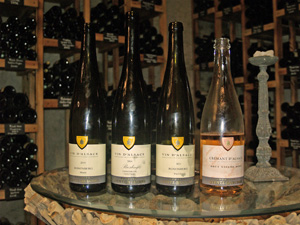
We continued the wine tasting over lunch, the 2018 Who Am I? Pinot Blanc, Pinot Gris and Riesling blend pairing the baeackeofe, one of Alsace’s quintessential specialties. With the local cheese board, we enjoyed the 2018 Pinot Noir Granit, and the 2019 Gewurztraminer Rosenberg with the blueberry tart.
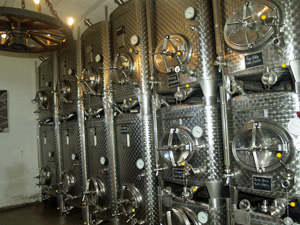
After lunch, Stéphane detailed the work remaining to be done in the vineyard before the harvest, and how he will choose when the right time to harvest is. We then retunred to the cellar to quickly visit the press, barrel room, and fermentation hall. We’ll be spending more time in the cellar during the Harvest Experience Day to see how the grapes are received, and during the Vinification Experience Day to learn more about the work during the fermentation, ageing, and bottling phases.
Many thanks to Stéphane and Céline for sharing their passion for their profession with us. We can’t wait to come back for the harvest!
Surprise your Dad with some adopted vines for his Fatherís Day gift this year
- Categories :
- Gifts
- Wine
- Enjoying Wine
- Gourmet Odyssey
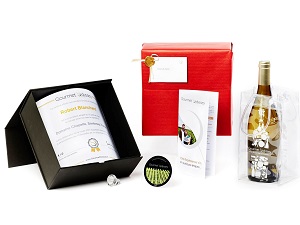
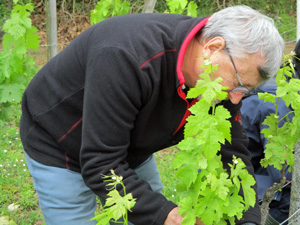
Benoît, the Gouret Odyssey wine expert, introduced us to the day while we enjoyed a coffee and croissant. Then Matthieu, who represents the 13th generation of winemaker at the winery, presented Château Coutet and its diversity of terroirs and grape varietals. It’s an exceptional place where the vines, trees, and family have been living together in perfect harmony for over 400 years.
In the vinification hall, Matthieu explained the fermentation phases, something that those of us who had already participated in the Harvest Experience Day had touched upon last September. Matthieu proved to be someone both very knowledgeable and passionate about the subject.
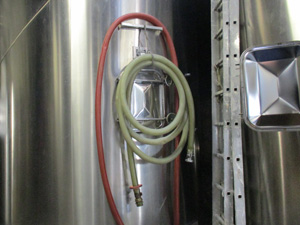
We then went through to the barrel room, where the wine is laid to rest and age in oak barrels once the fermentation has finished. Traditionally, wines are aged in oak barrels in Bordeaux. At Château Coutet, the aim is to limit the amount of wood that can be tasted in the wine, so the percentage of new barrels used is fairly low.
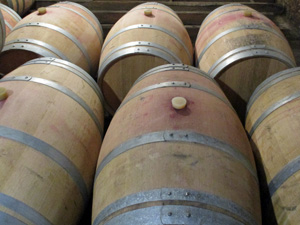
Back in the fermentation hall, Benoît then initiated us to the art of wine tasting, starting with a reminder of the basics, so that we were all talking the same wine language. We blind tasted a first series of wines, a very interesting exercise that enables us to better concentrate on the aromas and tastes to analyse the wines by avoiding being influenced by labels and any preconceived ideas that go with them.
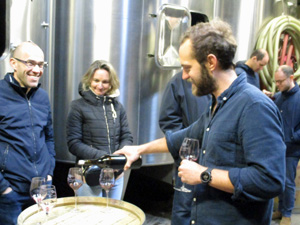
We continued with another blind tasting of the four grape varietals grown at the winery. This enabled us to identify the characteristics of each before having a go at blending them together in different proportions to create our own wines like real Saint-Emilion wine-makers!
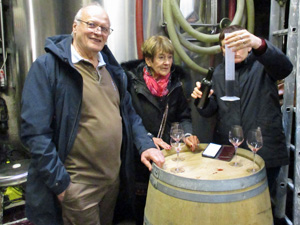
The morning flew by and before we knew it, it was time to sit down to lunch. We continued the wine tasting with the Vertige white wine made by a cousin of the family at Château Grand Verdus, which accompanied the Landais salad for the starter. The 2020 Château Coutet paired wonderfully with the beef brochette main course, ending with the magnificent 2018 Demoiselles wine, which has a long finish and complexity to it that matches the best of the Saint-Emilion wines.
After lunch, we made the most of the sun’s return to go and visit our adopted vines up on Saint-Emilion’s limestone plateau, surrounded by Château Coutet’s prestigious neighbours. We each found our vines thanks to a personalised slate that had been put out. We marvelled at the wonderful view, and took some photos in the hope of winning a magnum of wine in the “My Vine” photo competition.
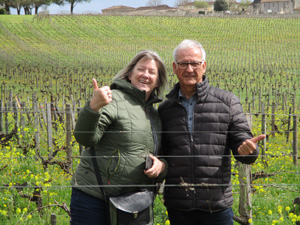
We finished the day with a visit to the cellar where the bottles are stored. Matthieu explained how the wine is bottled and labelled, the last remaining steps before the wine is ready to be sold and tasted.
Many thanks to Matthieu for his warm welcome, and to all the participants for this great day, that was as enjoyable as always.
The day started with a coffee and croissant to introduce ourselves to one another and discover the day’s full programme of events. The objective of the day was to learn the decisions the winemaker takes in the cellar when making wine, and as we were to learn it’s a complex task!
We divided the group into two for the morning’s two different workshops. One half started in the chai opposite the château with the winemaker, Marc. This building is home to the fermentation hall, the bottling and labelling line, and the logistical centre.
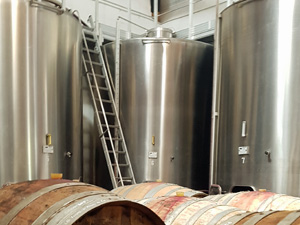
Marc had the honour of transforming our guests into apprentice winemakers through his explanations. He covered all of the most important steps from the harvest, through the fermentation and maceration phases, up until the wine starts the ageing process, which was to be our theme for the afternoon!
The other half stayed with Louise, Gourmet Odyssey’s wine expert, for a wine tasting workshop! It’s all very interesting to learn about how wine is made, but it’s also good to know how to taste it properly! We worked on the senses we use when tasting wines, in which order to use them, and the specificities of each step. Before putting our new found skills into practice, we put our noses to the test! Most of us are not used to paying close attention to the aromas that surround us, and we learnt that it is something we need to train to be able to better identify the subtle aromas and characteristic of different grape varietals.
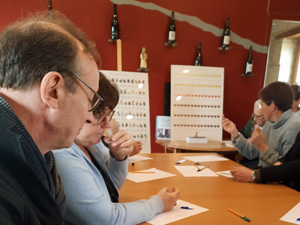
The groups were then swapped around before we all met up again for the aperitif and lunch, a good occasion to put into practice our morning’s work!
As always, Mme Plouzeau had prepared a wonderful meal, and we savoured the range of Château de la Bonnelière’s wines that we tasted. So much so that it was difficult to pull ourselves away from the table afterwards!
There remained two important activities: meeting our adopted vines in the vineyard next to the château and visiting the cellar underneath the Chinon Fortress.
The vines were in very good shape. They had recently been pruned and were impatiently waiting for the first warm days to burst back into life.
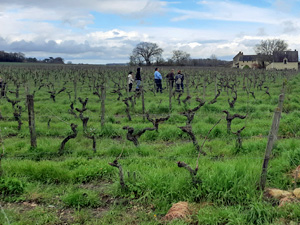
We then headed into Chinon to end the day. Marc has the very good fortune to own his own troglodyte cave, directly underneath Chinon’s fortress. He uses the cave as a cellar to age his wines in oak barrels from anything between one and three years depending on the wine and the vintage.
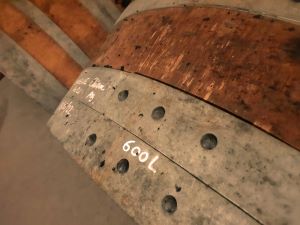
It’s a precise and painstaking job that requires patience and skill to know when a wine is ready, and which need longer. It took Marc years of trial and error to master. To give our participants a notion, we had the honour of tasting different wines to better understand how they change during the ageing process. It was a unique moment that everyone very much appreciated.
Before we knew it, the day drew to a close, and it was time for us to go our separate ways. Many thanks to all of those who took part and helped to make the day so special. Hopefully see you again soon!
The impact of global warming on winemaking in France
- Categories :
- Wine
- Wine News
- Wine Making
- Gourmet Odyssey
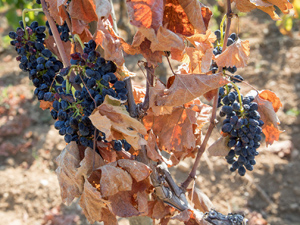
How is climate change impacting the vines?
What solutions are available to fight against climate change in the vineyard?
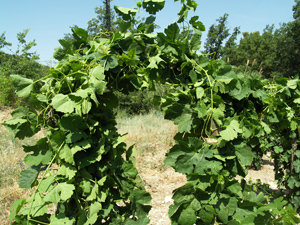
Regarding the frost, there are different methods available to protect the vines, but the most environmentally friendly way and simplest way is to delay the winter pruning. Traditionally, pruning started around December, depending on the region and size of the winery, but pruning is often now pushed back until March to delay the buds bursting and to protect the buds from the first frosts.
Some of these solutions might work today, but are they viable in the long term?
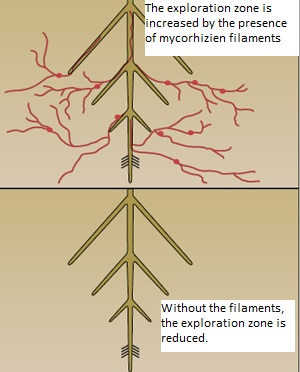
- Arinarnoa (origin INRA, 1956): Made from a hybrid of Tannat and Cabernet Sauvignon. Low sugar production, good acidity. Gives well structured, colourful, and tannic wines with complex and lasting aromas.
- Castets (origin south west France): An historic grape varietal, forgotten in Bordeaux. Resistant to grey rot, odium, and mildew. Allows to make colourful wines for keeping.
- Marselan (origin INRA, 1961): A hybrid between Cabernet Sauvignon and Grenache. A late developing varietal, resistant to grey rot, odium, and mites. Enables making colourful wines with character, of good quality and the potential for ageing.
- Touriga Nacional (origin Portugal): A very late developing varietal that is less at risk from spring frosts. Resistant to fungal diseases with the exception of dead arm wood disease. Makes very good quality wines that are complex, aromatic, full-bodied and good for ageing.
- Alvarinho (origin Iberian Peninsula): Marked aromatic characteristics that counterbalance the loss of aromas due to global warming. Resistant to grey rot. Medium sugar potential that enables the winemaker to produce subtle and aromatic wines with good acidity.
- Liliorila (origin INRA, 1957): Like the Alvarinho, it has good aromatic qualities giving powerful and scented wines.
What will happen if the climate situation doesn’t change in the next few years?
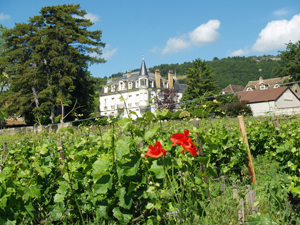
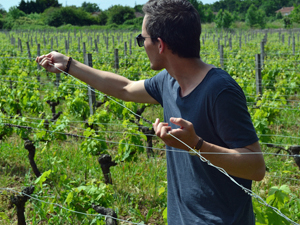
- All of the wineries are organically certified and carefully chosen for the quality of their wines
- The Wine Experience days last the whole day from 09:30 to 16:00, are valid for two people, and include lunch and wine-tasting
- It’s the winemakers themselves that welcome you to the winery to share their passion during the day, accompanied by a Gourmet Odyssey wine expert
- You have the choice of up to three Wine Experience days at the winery:
Thank you for this excellent day that I’ll remember fondly for a long time to come. (Vinification Experience Day at Domaine Stentz-Buecher, March 2022)
I got to realise how much technical knowledge is required, and also the artistry and continual attention that each vine needs. Thank you so much! (Discovery Experience Day at Château de la Bonnelière, June 2022)
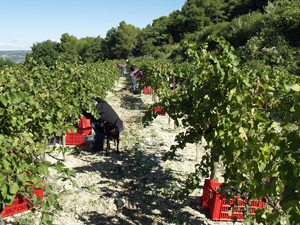
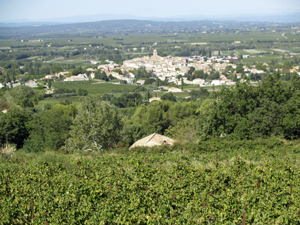
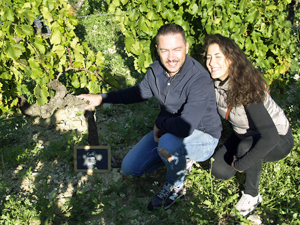
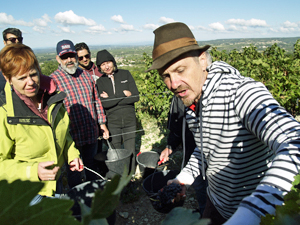
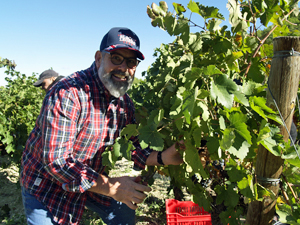
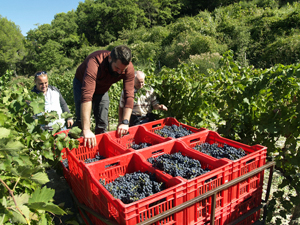
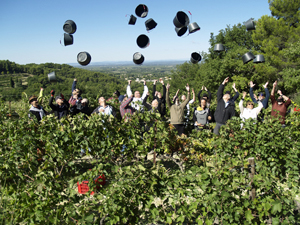
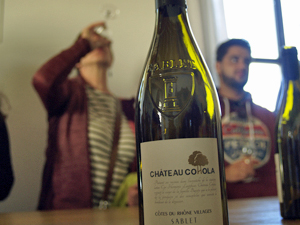
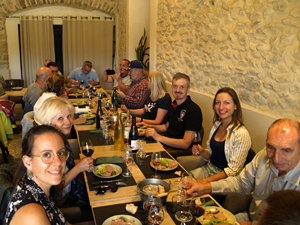
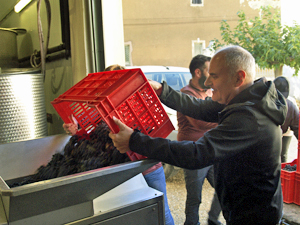
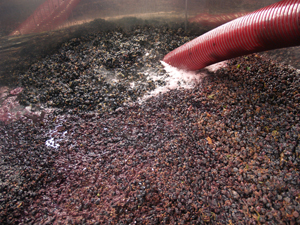
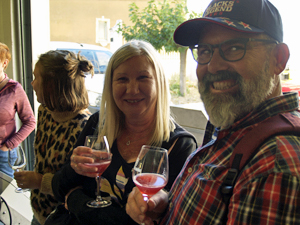
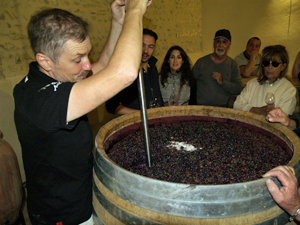
Harvesting organic grapes in the Loire Valley
- Categories :
- Gifts
- Wine
- Gourmet Odyssey
- Château de la Bonnelière
- Loire Valley
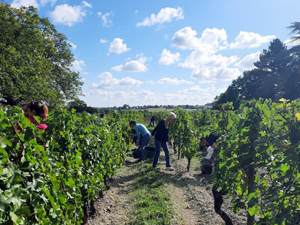
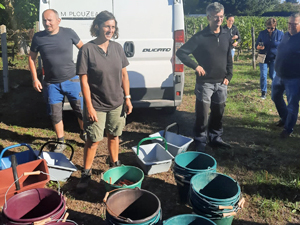
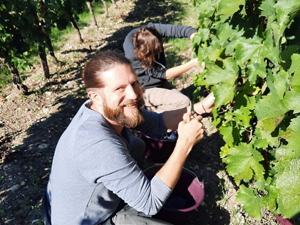
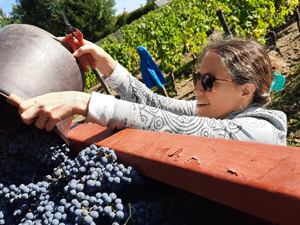
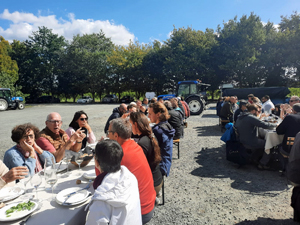
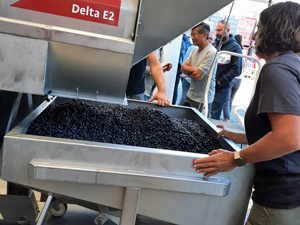
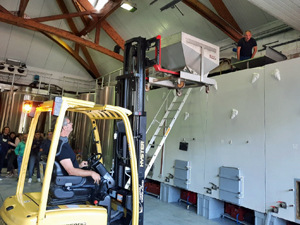
We welcomed our apprentice wine-makers to Domaine Chapelle in the Burgundy village of Santenay for the Harvest Experience Days on the 27th, 28th, and 29th August. 2022 is a very early year due to the high temperatures of the last few months. Our objective for the days was to pick the grapes, follow their journey into the vat, and to learn about all the work in the cellar during harvest time. There’s more to harvesting than just picking grapes!
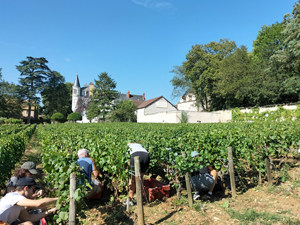
After an introduction to the day and the Gourmet Odyssey Wine Experience, and of Domaine Chapelle’s history, we walked to the “Clos des Cornières” and “Les Crays” vineyards, where the adopted pinot noir and chardonnay vines are to be found.
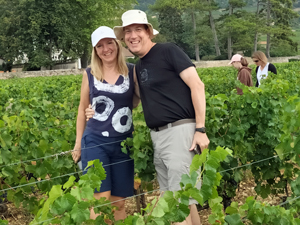
We took a few minutes to say hello to our adopted vines, and take some photos for the “My Vine” photo competition. A magnum of Santenay wine is up for grabs!
After this fun start, it was time to get down to the more serious business of harvesting, and so we gathered in the Clos des Cornières vineyard where the beautiful bunches of grapes from this exceptional vintage were waiting.
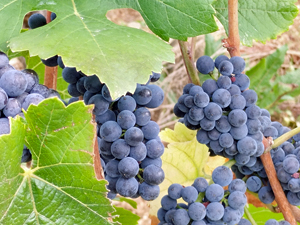
Climate-wise, the last couple of years have been challenging, and so we were delighted that the 2022 vintage had produced such good quality grapes, and of a normal quantity!
Jean-François and Simon gave us each a pair of secateurs and explained how to pick the grapes, which ones to harvest and which to leave on the vine. The ripe grapes are located at the bottom of the vine and, as we quickly noticed, the vines in Burgundy are very low to the ground!
In pairs, we each took a row and started the harvest. First we removed the leaves around the grapes to see them better. This makes it much easier to cut the bunches without taking our fingers with them!
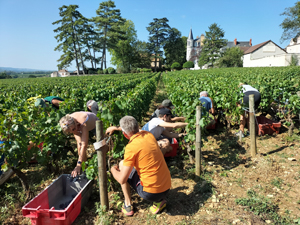
We put the cut grapes into crates, which is the best way to harvest pinot noir due to their delicate skin. The crates avoid the grapes being squashed by the weight of other grapes above them, ensuring that they arrive in the cellar in the best possible condition.
Harvesting is a physically demanding job as our backs and legs could testify! But it’s also very rewarding and satisfying to see the rates full of delicious grapes! And to arrive at the end of the row!
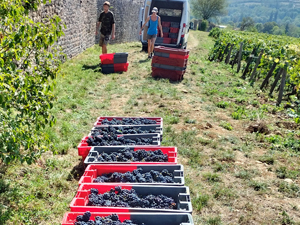
Once the crates were full, we brought them back to the beginning of the row to be taken back to the winery in the van.
After the effort, our reward was a lovely glass of chilled 2020 Santenay Villages white wine which we enjoyed in the garden, accompanied by the famous Burgundy gougères.
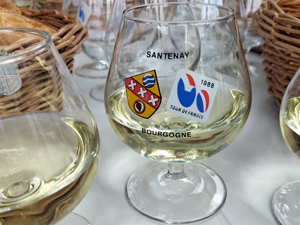
We then sat down to enjoy lunch. Poached egg on a bed of mushrooms, veal risotto and potatoes, and a framboisier to finish. The courses were accompanied by a Burgundy Aligoté, a 2019 Santenay Clos des Cornières, and a 2016 Santenay Les Gravières Premier Cru. All delicious!
In the afternoon, we made our way to the sorting table to participate in the process involved in putting the grapes into the vat.
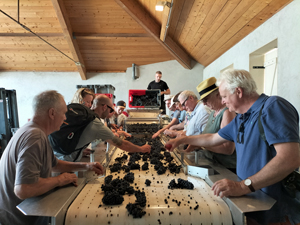
We learnt how the work is organised around the sorting table and we got involved. The quality was so good this year that we didn’t have a very stressful job! We did however have to remove some of the grapes that had been scorched and had dried out due to the drought, but fortunately there weren’t very many.
We then went down into the fermentation hall, one floor below. The grapes that had been separated from their stalks by the de-stemming machine fall into a trolley using the power of gravity. Once the trolley is full, it is pushed next to the vat to be filled, and the grapes poured into a vertical conveyor belt, known as the giraffe, which carries the grapes up into the vat without the need for a pump.
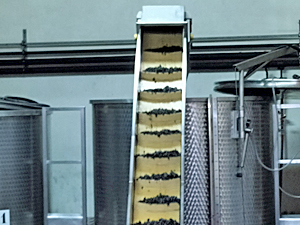
This method of putting the grapes into the vat treats the grapes very gently, keeping each individual berry as intact as possible to start the maceration phase before fermentation starts.
For three days, the harvested grapes are kept cold during the initial maceration stage, and then the temperature is warmed to allow the fermentation to begin. This will last for approximately 10 days. At the same time, the maceration continues and the tannins and colours are extracted by pigeage and pumping over. The maceration phase lasts for around three weeks.
Then comes the time to separate the wine from the solid matter, and to put the wine in the oak barrels to start the ageing process which will last for around one year. We’ll learn more about the rest of the work in the cellar after the harvest and up until bottling during the Vinification Experience Days in spring next year.
And so the day drew to a close and having collected some bottles of wine for the most part, we parted company, promising to come back soon to discover more of the Burgundy terroir in Santenay!
The key steps involved in wine tasting
- Categories :
- Gifts
- Wine
- Wine News
- Wine Making
- Enjoying Wine
- Gourmet Odyssey
Step 1 : The look
The first step is to place your glass of wine above a clear white surface, ideally in the light. You’ll be able to judge how clear it is based on the number of particles that are held in suspension, and gauge its level of acidity. If you can see thick tears form on the inside of the glass, it’s a sign that the wine is full-bodied, and inversely if the tears are finer and flow more quickly, the wine is likely to be more acidic.
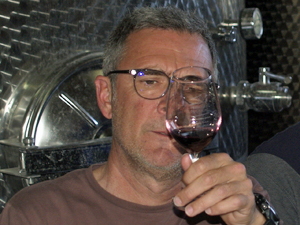
You can also pick up some clues regarding the wine’s age to indicate whether the wine is likely to be young or old. For red wines, the colour changes from bright red or purple for the youngest wines to a rusty colour for the older ones. And for the white wines, from pale yellow or even green to a deep amber colour.
Step 2 : The nose
This phase is done in two parts. Without moving the glass, place your nose over the glass and take in a big sniff. This is known as the first nose. Then swill the wine carefully around the glass a few times to oxygenate the wine and liberate the less volatile aromas before sniffing again. This is known as the second nose. Often, there is a big difference between the first and second noses.
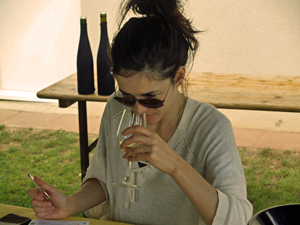
There are different types of aromas; primary, secondary, and tertiary aromas. The primary aromas come from the grapes themselves, and there are a wide range of smells such as floral ones (acacia, honeysuckle, jasmin, rose, lilac etc.), fruity aromas (pineapple, apple, lemon, mango, peach, apricot, raspberry, blackcurrant, blueberry, etc.), vegetal aromas (aniseed, thyme, grass, pepper, fennel etc.), or spicy aromas (cinnamon, pepper, nutmeg, etc.)
The secondary aromas come from the fermentation, and we can find three distinct types. There are those that are produced by the fermentation process such as brioche, yeast or biscuit. There are also the milky aromas such as butter, yoghurt or milk, and the alcoholic aromas such as boiled sweets, nail polish, or banana.
The tertiary aromas develop during the ageing process, several months after the harvest. Oak barrels give woody aromas such as cedar, oak, vanilla, and eucalyptus, spicy aromas such as pepper, cinnamon, and liquorice, or toasted aromas such as toast, coffee, grilled almonds, or tabaco.
Step 3 : The taste
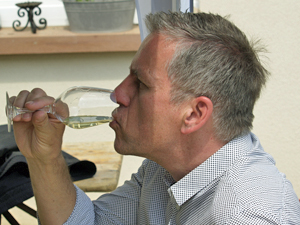
When finally getting to the tasting stage, take a small amount of wine in the mouth, breath in a little air between the lips, swill the wine around the mouth, then breath out of the nose to let the taste and aromas to develop, before swallowing the wine or spitting it out.
There are three moments to take note of:
- The attack. What impression does the wine give the moment you take it into your mouth? It can be weak, strong, or intense.
- The mid-palate. Analyse the texture of the wine and the aromas. Is it smooth, acidic, are there any new aromas that have developed since step 2?
- The finish. Once you’ve swallowed the wine, what sensation prevails, and how long does the taste last? If there are lots of tannins present it will have a longer finish, and a wine that is fruitier is likely to have a shorter finish.
Using our senses is very important in tasting wine, and by following these stages, you will be able to comment on a wine more easily, and to compare it with others. Wine-tasting skills improve with practice and remembering the characteristics of the wines that you have previously tasted. You can always use a notebook to write down your thoughts. And remember the two most important things when tasting wine. It starts with “I like the wine, or I don’t”. And secondly, we all have our own perceptions of smell and taste, and so it is remains very subjective!
To develop your wine tasting skills further, you can participate in a Vinification Experience Day and learn directly from the winemaker and a Gourmet Odyssey wine expert. Each of the partner wineries are organically certified, and the wine-making course teaches you about all that happens in the cellar from the harvest, right up until the moment when the wine is ready for drinking During the day, you’ll see how the fermentation phases change the structure of the wine, participate in a wine-tasting workshop to help you develop your senses, taste wines that are in the ageing process, and get involved in blending different wines.




